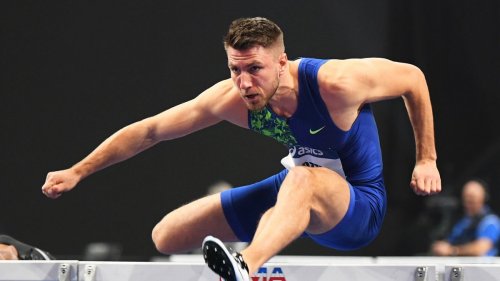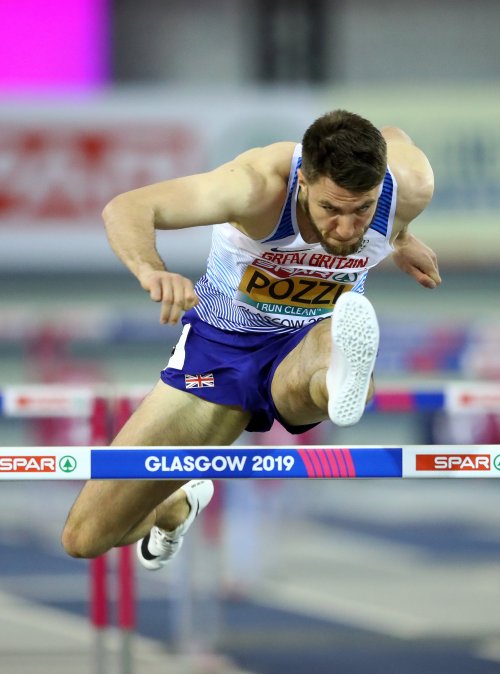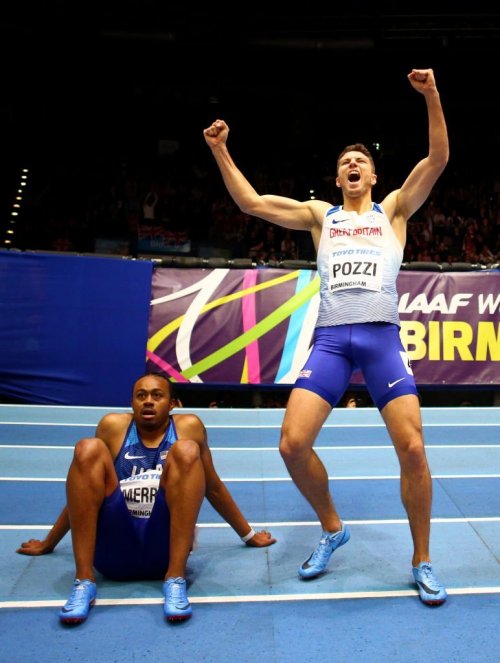This is part 3 on Andrew Pozzi, the top GB hurdler, by Stuart Weir. In this piece, we learn a bit more on how Pozzi is motivated and also how he sees the hurdles’ challenges.
Andrew Pozzi recently moved to the PUMA brand as his key sponsor.
 Andrew Pozzi, photo by British Athletics
Andrew Pozzi, photo by British Athletics
Andrew Pozzi Part 3 – Intensity, consistency and more
In the final piece Andrew Pozzi explains the nature of the high hurdles, how important consistency is and how you achieve it. “Intensity” is another word which crops up regularly. It is obvious how analytical he is, dissecting his races and learning the lessons from them.
” With hurdles, especially when you’re changing things technically, you have to go up through the levels of intensity to make it stick because it becomes more difficult the higher intensity you go. I felt there were a number of little kinks to iron out which would’ve been much easier with a full Diamond League series or if we had all been preparing for a championship with every race of a higher level.
“The event is so intriguing for me because once you get past hurdle one, your progress is interrupted every three strides by a hurdle. So typically in the hurdles, one mistake is much more costly than in any other event. If you make a mistake early in the race it’s much more difficult to get back up to speed or to get your rhythm back. Even a small mistake like, clipping a hurdle, can mess up your rhythm can make you lose your speed.
🔥 @WorldAthletics https://t.co/W1J0tTgs5D
— Andrew Pozzi (@andrew_pozzi) December 17, 2020
“Last year I ran similar times in different ways, which showed me that there’s a lot more available. Take Rome for example, I was quite steady – even slow – to the third hurdle, had a good middle section and in the end was very strong – controlled rather than attacking again. When you look at the breakdown between hurdles in a more consistent race they are better times. In Savona I ran 13.30 with a phenomenal start but then it was much more pedestrian. You need to combine the best bits of the races – which is typically what happens when you have more consistency at a higher level. Normally we would have about six Diamond Leagues so that by the time you get to the championship you have refined the inconsistencies. But in 2020 they were just two Diamond Leagues and a lot of domestic races and all through the season we didn’t know what would be canceled and want to go ahead, which made it more difficult to get that consistency of level. The nature of 2020 was that whatever anyone ran, you can be pretty sure in a normal year they would run faster because sprint hurdles is an event where you need consistency at the highest level in order to get the best out of yourself. We did a good job of making the best of last year but achieving that consistency wasn’t really possible.
More finals like this in Torun, please! ðŸ™
📺 Re-watch Andrew Pozzi (@andrew_pozzi) take on reigning champion Pascal Martinot-Lagarde (@PascalMartinot) in the 60m hurdles final in Belgrade 2017. 🚧
— European Athletics (@EuroAthletics) January 17, 2021
“There are so many things to focus on and when there’s an abundance of races at the highest level it becomes second nature because you really pick up the rhythm. But in an absence of that you have to be a lot more thoughtful about what it is you are focusing on.
“By Rome, at the end of the season, I was quite fatigued – which is why I didn’t go to Doha. But Rome was technically my most together but the intensity had dropped a little because it had just been such a long season at that stage. But in Turku having two races (prelim and final) was really important because it was my first step up from domestic Italian races to a race with a lot more international hurdlers. I needed to get up to maximum intensity as quickly as possible and heats help with that. I also asked theorganizers to make the heats as strong as possible so that it was almost like two finals which helped get the intensity up. You want as high level of possible. 13.25 in Turku prelim was, I think, the second fastest I’ve ever done in the heat. In Paris 2017 I ran 13.24 and in the final 13.14. So I really like heats and final. In Turku it was really appropriate. In Monaco I was happy with just one race, only because it was just three days after Turku and my body was a little bit fatigued in Monaco off the back of Turku. Typically I wouldn’t have taken two races so close together but given the ‘Covid year’, you didn’t know when high-quality opportunities would come, so I had to grab both of them. That being said, it worked out well and had I not done Turku, I might not have been a strong in Monaco – because Turku gave me a good warm-up for Monaco. But had Monaco been a few days later I would have been better prepared!”
 Andrew Pozzi, photo by Getty Images / British Athletics
Andrew Pozzi, photo by Getty Images / British Athletics
Training has gone well this winter: “Where I am in Italy – Formia, a small coastal town in Southern Italy, halfway between Rome and Naples – it was relatively normal. It was different and certainly less easy because the training centre was shut or rather the recovery areas were shut – the ice bath and the heat bath were all shut. That made life more difficult. Only one of the gyms was open and you had to book time slots. Normally I would do a track session and then go to the gym but often we would do a track session and the gym would not be available for another hour. But the training centre here has really tried to do the best it could for the athletes. And I really appreciate that. They have been as accommodating as possible but there are some issues – like the recovery baths – which the legislation doesn’t allow them to open, which I completely understand. I was very fortunate. I was in the gym relatively normally most of the time were as I know that in the UK that was much tougher. We did OK and we’d been very lucky that the training centre has been as accommodating as they possibly could within the law”.
His plan is to open his season on January un Karlsruhe, Germany and to have a full indoor season and including the European indoors, “unless there’s any reason to reconsider”. Then the focus will shift to the outdoor season: “We’ve done lots of technical work this winter which is largely the foundation for the outdoor. After the European Indoors I would take a week of complete rest and then go back into the foundation work prepping for the outdoor season. One of the best things that last year showed is that in a very difficult circumstances – I had three months away from my coach and without full use of the track – we still prepared really well. I think we learned what works for me and what training gives me a lot. That is something useful to take into this year”.
 Andrew Pozzi, photo by Getty Images / British Athletics
Andrew Pozzi, photo by Getty Images / British Athletics
Author

Since 2015, Stuart Weir has written for RunBlogRun. He attends about 20 events a year including all most global championships and Diamond Leagues. He enjoys finding the quirky and obscure story.
View all posts




















